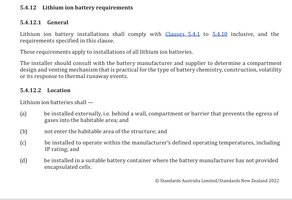As usual new regulations do not consider the potential knock on effect. I think the biggest issue now will be Insurance cover in the event there was a fire attributed to the Lithium batteries...all caravan policies now will include some sort of appendix with conditions...if the battery system was installed by some one other than the manufacturer...ie self
Majority of policies will now include something like this;
OEM
OEM means the original equipment manufacturer of the electronically driven equipment or a company approved and/or licensed by the
original equipment manufacturer;
The following is added to the General Conditions Section of this Policy:
CONDITIONS FOR LITHIUM FIRE EXPOSURE AND CLAIMS
You must ensure as reasonably practicable:
• that the charging of any Lithium Battery is monitored for fire, temperature, smoke, damage and charge status and shall only be
performed
using charging equipment supplied or approved by the OEM;
• the location where any Lithium Battery is charged shall be free of any sources of ignition or flammable materials;
• all OEM guidelines and recommendations in relation to the use, installation, storage, charging and maintenance of any Lithium Battery
should be complied with; and
• any repairs, modifications, alterations to any Lithium Battery or its charging equipment shall only be performed by a licensed installer
and as per the OEM guidelines.
Unless otherwise stated in the Schedule, in the event of a Lithium Battery fire triggered claim an additional Excess of $2,500
That wording in itself opens a can of worms...The charging of the Lithium Battery.....using charging equipment supplied or approved by the OEM.
So if you have your what ever name Chinese Lithium Batteries being charged by say a Victron battery charger...how is it that the original Chinese manufacturer could be approached and asked whether they approve a Victron battery charger?
The only out clause really is "as reasonably practicable:" it may not be reasonably practicable to contact some Chinese manufacturer.
Note also..."Location of Lithium battery shall be free of ignition sources and flammable materials." That really means the only option is mounted in a tin box as any plastic or wooden structure or framing near the battery could be considered flammable.
So even if you, as in my case, installed Lithium batteries well prior to the new regs, the Insurer could get you anyway...but, it is only a $2500 penalty IF it was proved the batteries caused or started the fire...so it's not like your whole claim will be refused...
So for those of us with vans built prior to 2023 are stuck with having to attempting to find somewhere inside or under the van to mount a tin box for Insurance compliance purposes, therefore nothing will be "cheap" to fix or modify...

